Discover 10 stunning flowers that look like Sunflower. Explore these sunflower doppelgangers to add radiant beauty to your garden with these vibrant blooms.
The Sunflower, with its vibrant yellow petals and unmistakable radiant beauty, is a beloved flower that has captured the hearts of gardeners and nature enthusiasts alike. But did you know that there are other flowers that bear a striking resemblance to this iconic bloom? These sunflower doppelgangers come in various shapes, sizes and colors, adding an unexpected twist to the classic sunflower aesthetic.
In this captivating guide, we’ll explore ten stunning flowers that look like sunflowers, each one a unique and delightful addition to any garden or floral arrangement. Get ready to be amazed by the diversity of nature’s artistry as we unveil these radiant beauties.
1. Black-Eyed Susan (Rudbeckia hirta)
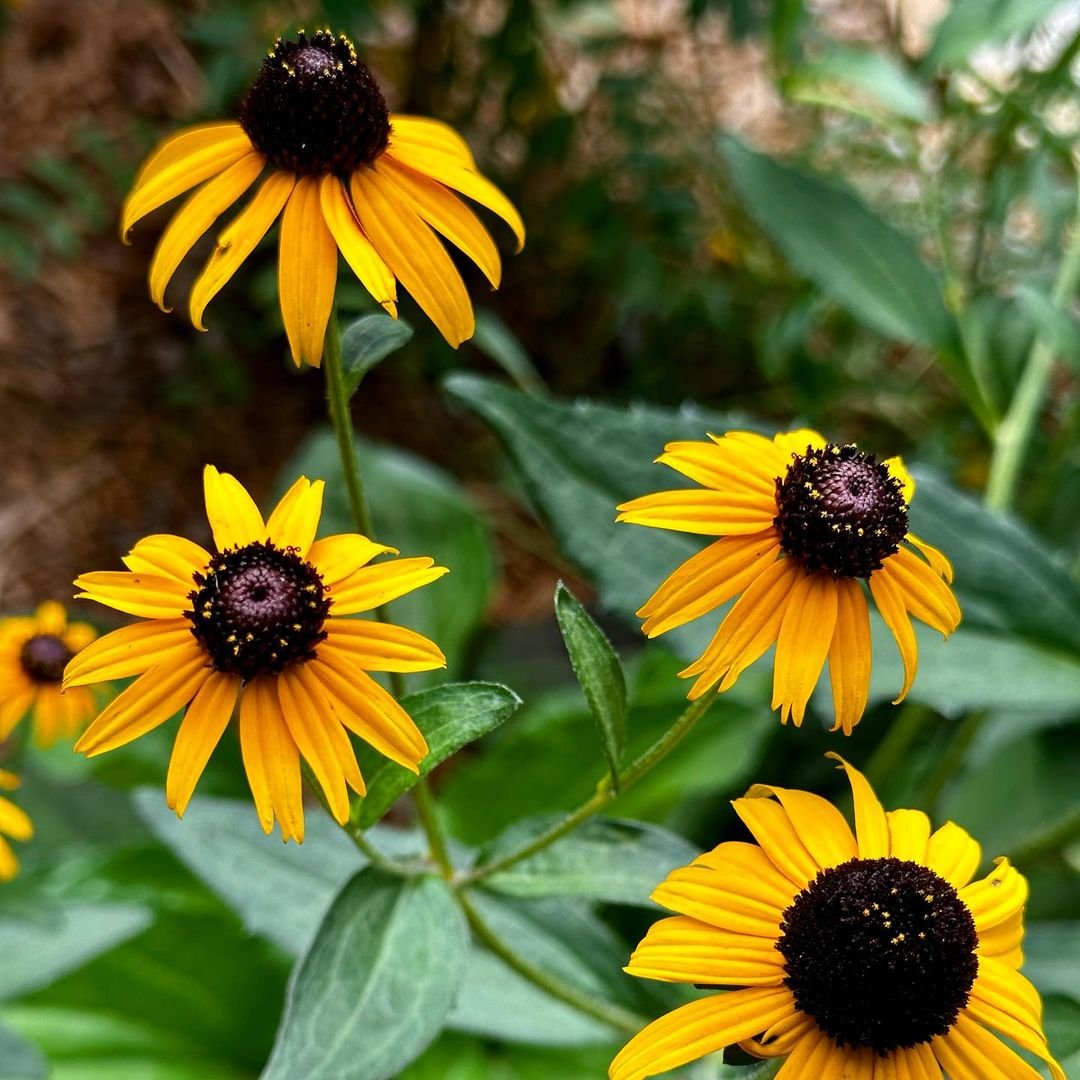
Here’s a short information chart for Black-Eyed Susan (Rudbeckia hirta):
| Aspect | Details |
|---|---|
| Botanical Name | Rudbeckia hirta |
| Common Name | Black-Eyed Susan |
| Plant Type | Herbaceous perennial or annual |
| Zones | USDA zones 3-9 |
| Sun Exposure | Full sun to part shade |
| Soil Type | Well-draining, fertile soil |
| Watering | Moderate; tolerate drought once established |
| Growth Habit | Upright, clumping |
| Height/Spread | Typically grows 1-3 feet tall with a spread of 1-2 feet |
| Special Features | Daisy-like flowers with yellow or orange petals and a dark brown center, blooms from summer to fall, attracts butterflies and bees |
Kicking off our list is the vibrant and cheerful Black-Eyed Susan. This robust perennial features golden-yellow petals surrounding a distinctive dark brown or black center, reminiscent of a sunflower’s distinctive face. Native to North America, Black-Eyed Susans are not only beautiful but also drought-tolerant and easy to grow, making them a fantastic choice for creating a sunflower-inspired garden.
2. Mexican Sunflower (Tithonia rotundifolia)
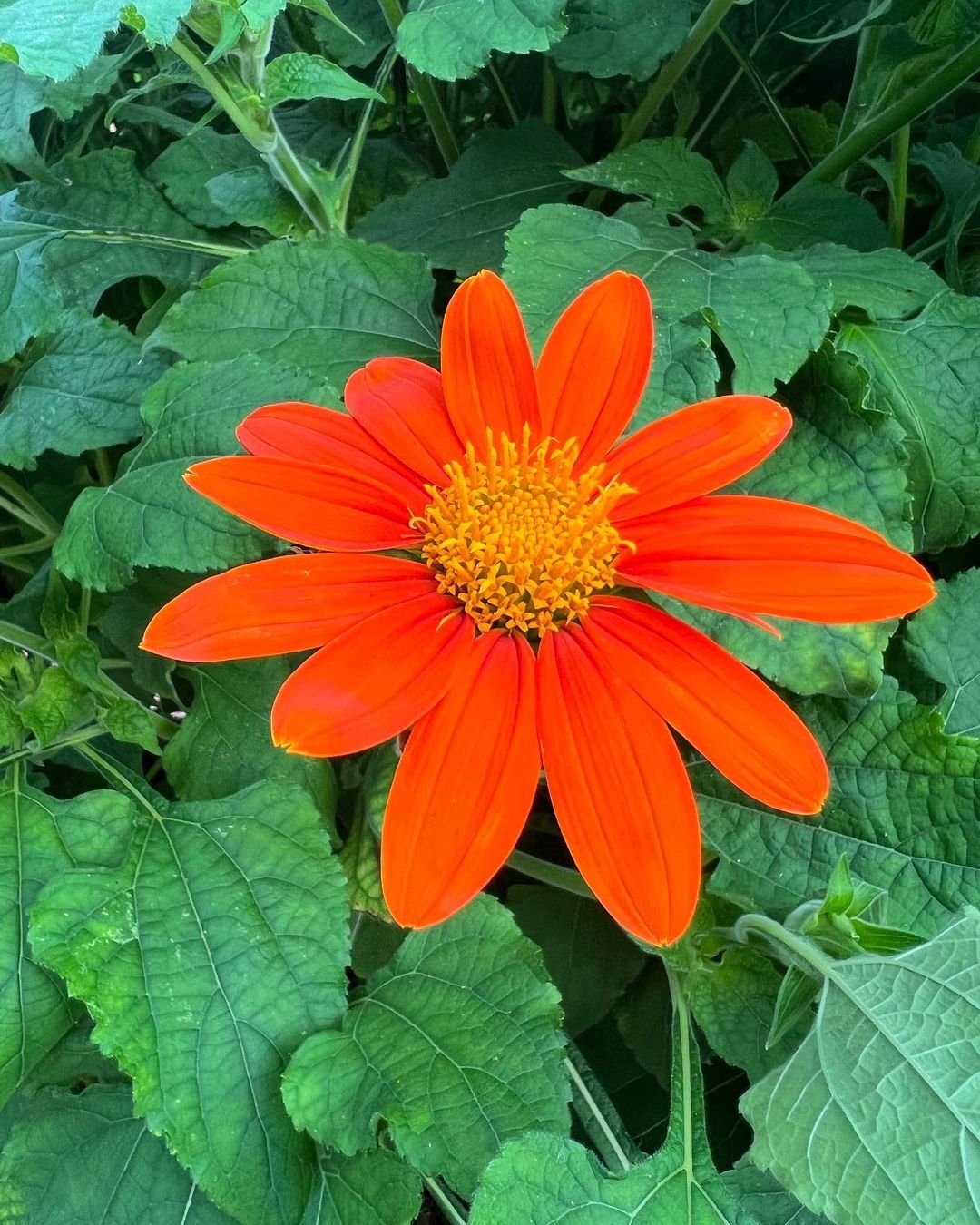
Here’s a short information chart for Mexican Sunflower (Tithonia rotundifolia):
| Aspect | Details |
|---|---|
| Botanical Name | Tithonia rotundifolia |
| Common Name | Mexican Sunflower |
| Plant Type | Annual |
| Zones | USDA zones 9-11 (typically grown as an annual in colder climates) |
| Sun Exposure | Full sun |
| Soil Type | Well-draining, fertile soil |
| Watering | Moderate; drought tolerant once established |
| Growth Habit | Upright, bushy |
| Height/Spread | Typically grows 4-6 feet tall with a spread of 1-2 feet |
| Special Features | Large, bright orange or red-orange flowers resembling daisies, attracts pollinators including butterflies and bees, excellent cut flower |
The Mexican Sunflower, also known as the “Torch Flower,” is a true showstopper. Its large, vibrant orange-red blooms can reach up to 4 inches in diameter, mimicking the bold and fiery appearance of a sunflower. This annual flower thrives in hot, sunny conditions and attracts a variety of pollinators, making it a valuable addition to any butterfly or pollinator garden.
3. Blanket Flower (Gaillardia spp.)
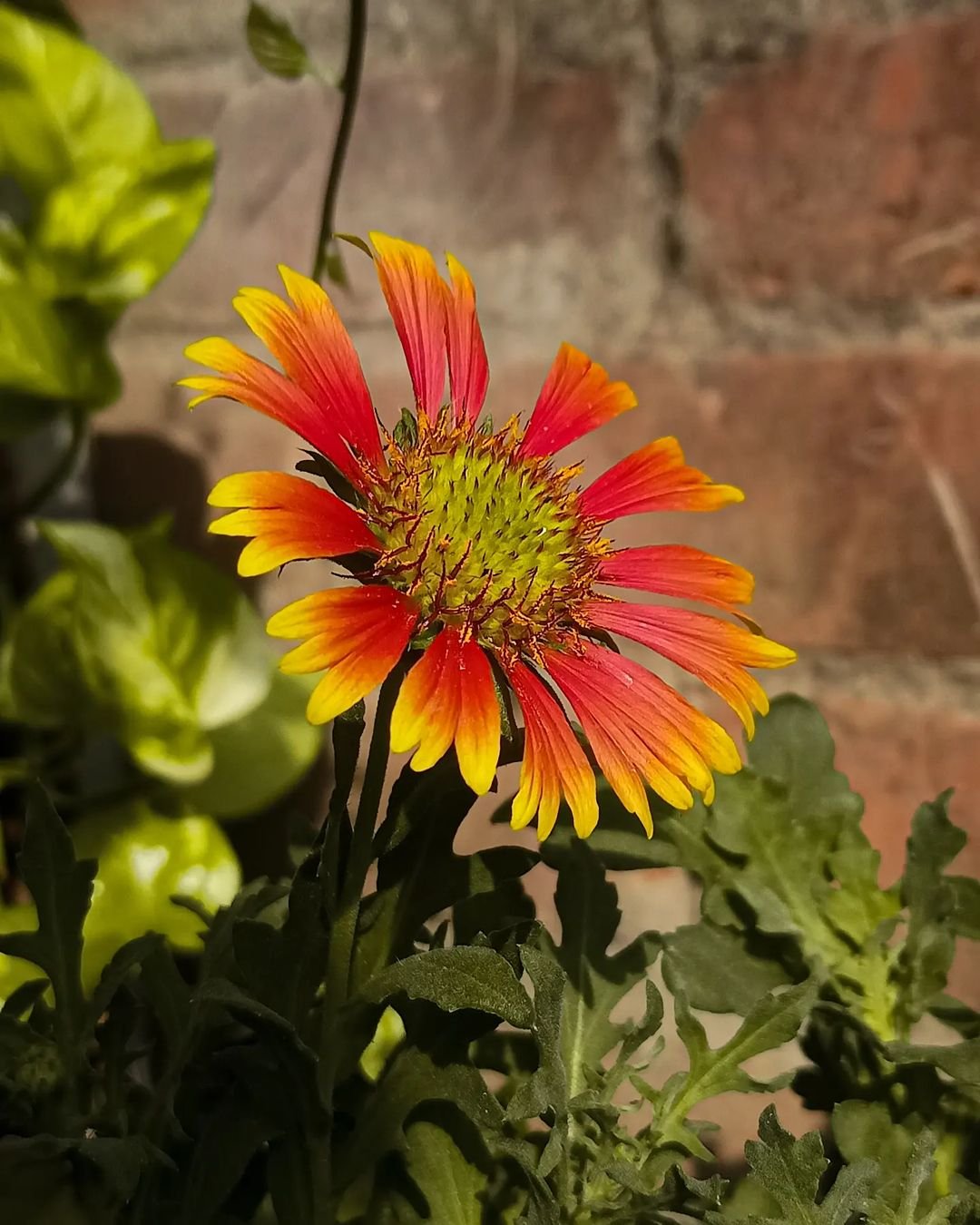
Here’s a short information chart for Blanket Flower (Gaillardia spp.):
| Aspect | Details |
|---|---|
| Botanical Name | Gaillardia spp. |
| Common Name | Blanket Flower |
| Plant Type | Herbaceous perennial or annual |
| Zones | USDA zones 3-10 depending on species |
| Sun Exposure | Full sun |
| Soil Type | Well-draining, sandy to loamy soil |
| Watering | Moderate; drought tolerant once established |
| Growth Habit | Upright, clumping |
| Height/Spread | Typically grows 1-3 feet tall with a spread of 1-2 feet |
| Special Features | Daisy-like flowers with vibrant red, yellow and orange petals, blooms from late spring to fall, attracts butterflies and bees, excellent for borders and containers |
The Blanket Flower, a member of the daisy family, is a delightful sunflower doppelganger. Its stunning blooms feature a warm blend of yellow, orange and red petals surrounding a prominent brown or dark red center, resembling a miniature sunflower. These hardy perennials are native to North America and are known for their drought-tolerance and long-lasting bloom time.
4. Coreopsis (Coreopsis spp.)
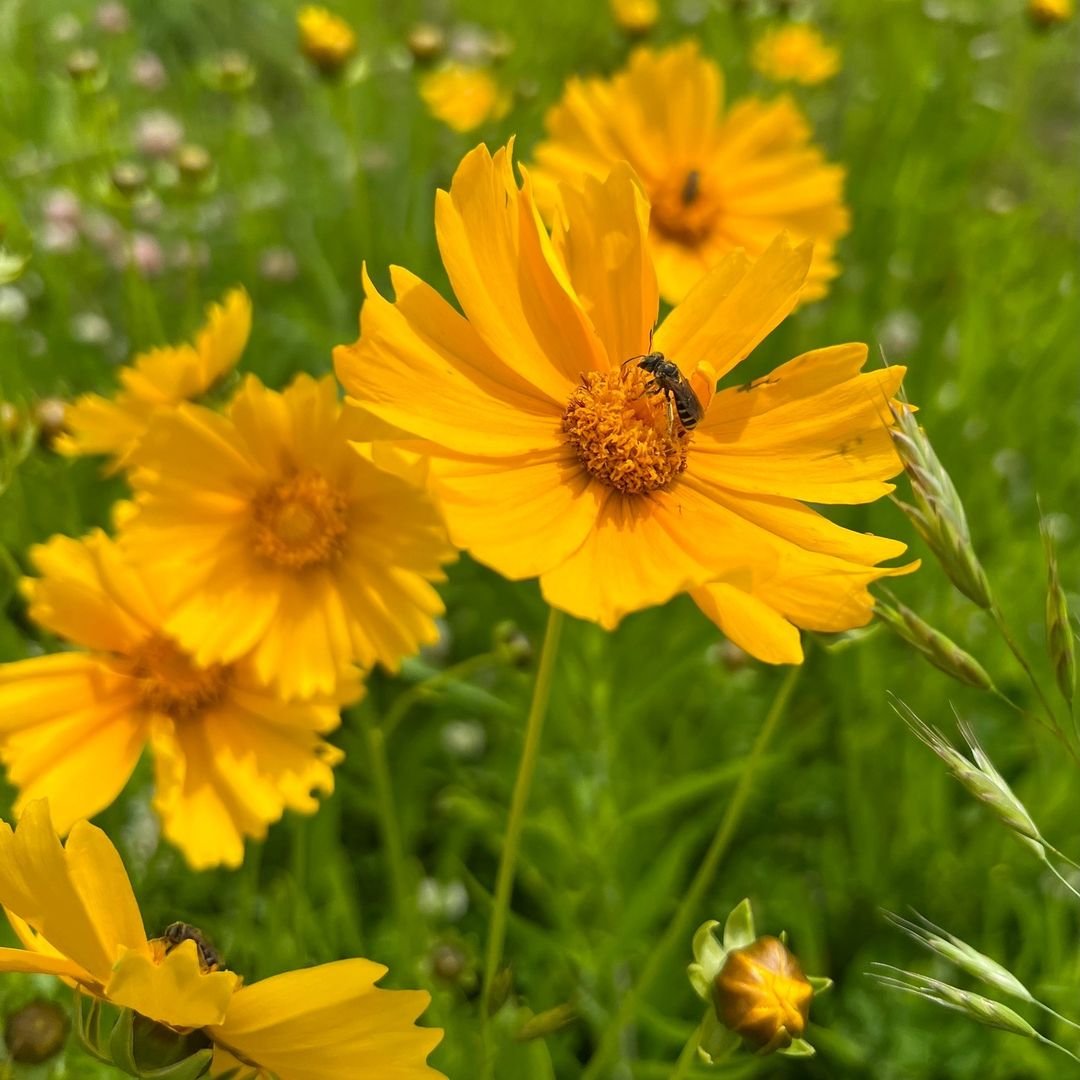
Here’s a short information chart for Coreopsis (Coreopsis spp.):
| Aspect | Details |
|---|---|
| Botanical Name | Coreopsis spp. |
| Common Name | Coreopsis |
| Plant Type | Herbaceous perennial or annual, depending on species |
| Zones | USDA zones 3-9 depending on species |
| Sun Exposure | Full sun to part shade |
| Soil Type | Well-draining, average soil |
| Watering | Moderate; drought tolerant once established |
| Growth Habit | Upright, clumping |
| Height/Spread | Varies by species, typically 1-3 feet tall with a spread of 1-2 feet |
| Special Features | Daisy-like flowers in shades of yellow, orange, pink or red, blooms profusely from late spring to fall, attracts butterflies and bees, excellent for borders and wildflower gardens |
With their cheerful yellow petals and vibrant centers, the Coreopsis flowers are a wonderful sunflower doppelganger. These easy-to-grow perennials come in a variety of shades, from bright golden yellow to deep orange and thrive in sunny locations. Coreopsis flowers are not only beautiful but also drought-tolerant and low-maintenance, making them an excellent choice for gardeners of all skill levels.
5. Gerbera Daisy (Gerbera jamesonii)
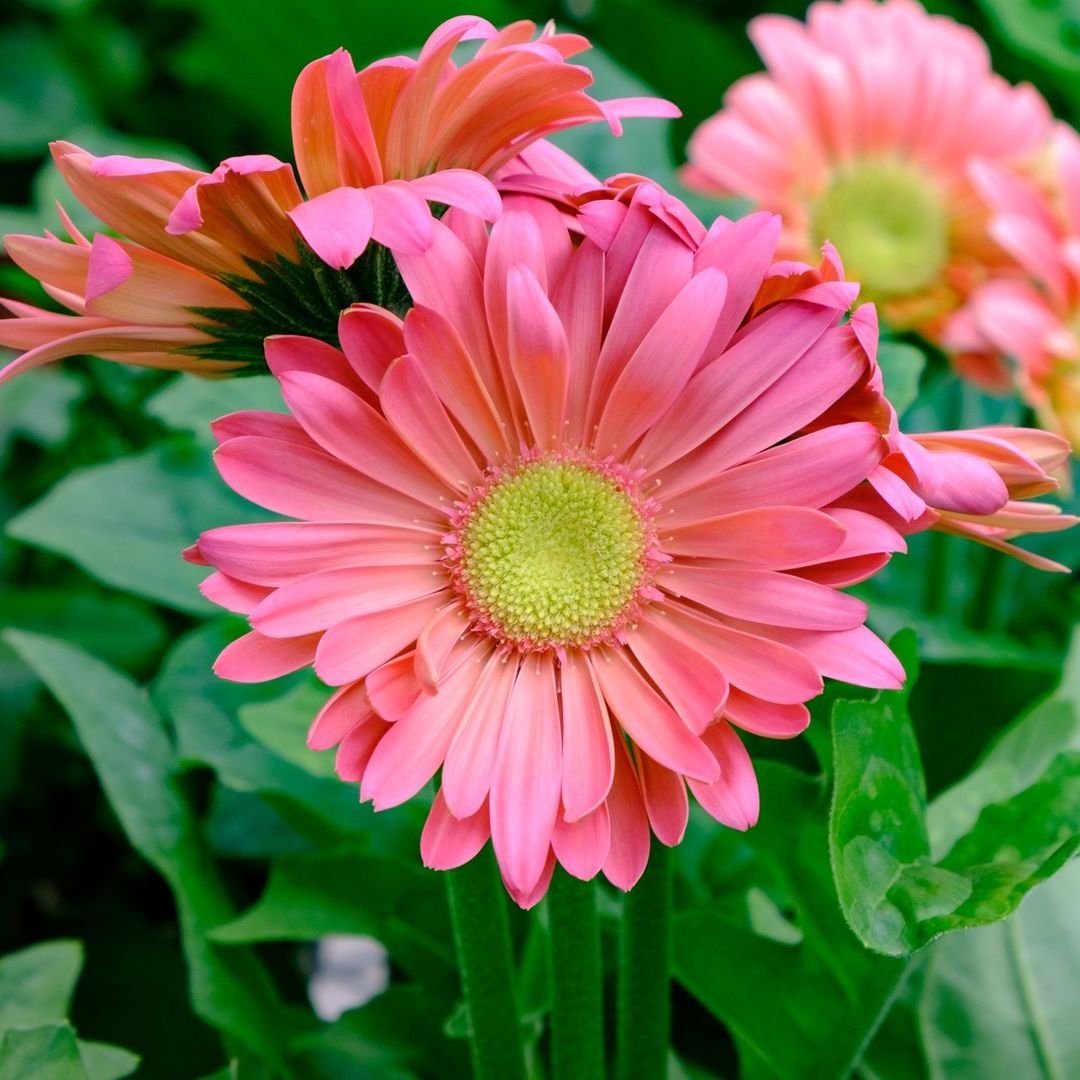
Here’s a short information chart for Gerbera Daisy (Gerbera jamesonii):
| Aspect | Details |
|---|---|
| Botanical Name | Gerbera jamesonii |
| Common Name | Gerbera Daisy |
| Plant Type | Herbaceous perennial |
| Zones | USDA zones 8-11 (typically grown as an annual in colder climates) |
| Sun Exposure | Full sun to part shade |
| Soil Type | Well-draining, fertile soil |
| Watering | Regular; keep soil evenly moist |
| Growth Habit | Rosette-forming, basal |
| Height/Spread | Typically grows 8-18 inches tall with a spread of 12-18 inches |
| Special Features | Large, colorful daisy-like flowers in various shades (pink, red, orange, yellow, white), long-lasting blooms, excellent as cut flowers |
The striking Gerbera Daisy, with its large, sunflower-like blooms, is a true showstopper. These vibrant flowers come in a wide range of colors, including shades of yellow, orange and red, mimicking the warm hues of a classic sunflower. Gerbera Daisies are not only beautiful but also long-lasting, making them a popular choice for both gardens and cut flower arrangements.
6. Gazania (Gazania spp.)
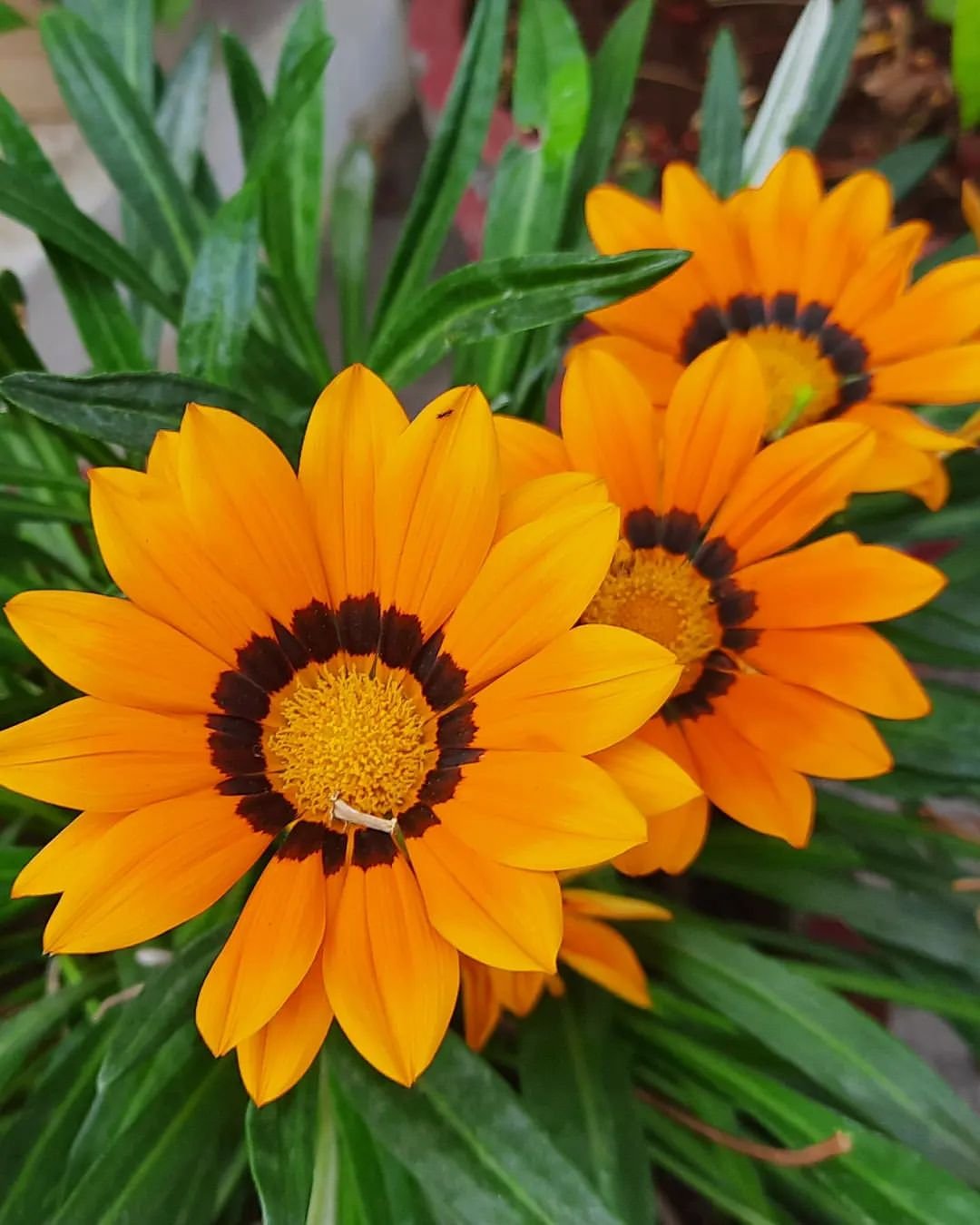
Here’s a short information chart for Gazania (Gazania spp.):
| Aspect | Details |
|---|---|
| Botanical Name | Gazania spp. |
| Common Name | Gazania |
| Plant Type | Perennial or annual herbaceous plant |
| Zones | USDA zones 8-11 (typically grown as an annual in colder climates) |
| Sun Exposure | Full sun |
| Soil Type | Well-draining, sandy to loamy soil |
| Watering | Moderate; drought tolerant once established |
| Growth Habit | Low-growing, spreading |
| Height/Spread | Typically grows 6-12 inches tall with a spread of 12-18 inches |
| Special Features | Bright, daisy-like flowers in shades of yellow, orange, red, pink or white with contrasting markings, blooms profusely throughout the summer, excellent for ground cover or containers |
The Gazania, also known as the “Treasure Flower,” is a stunning sunflower doppelganger that hails from South Africa. Its bright yellow or orange petals, often striped or ringed with contrasting colors, surround a distinctive dark center, creating a striking resemblance to a sunflower. These drought-tolerant and low-maintenance flowers are perfect for adding a touch of sunflower charm to any sunny garden.
7. Osteospermum (Osteospermum spp.)
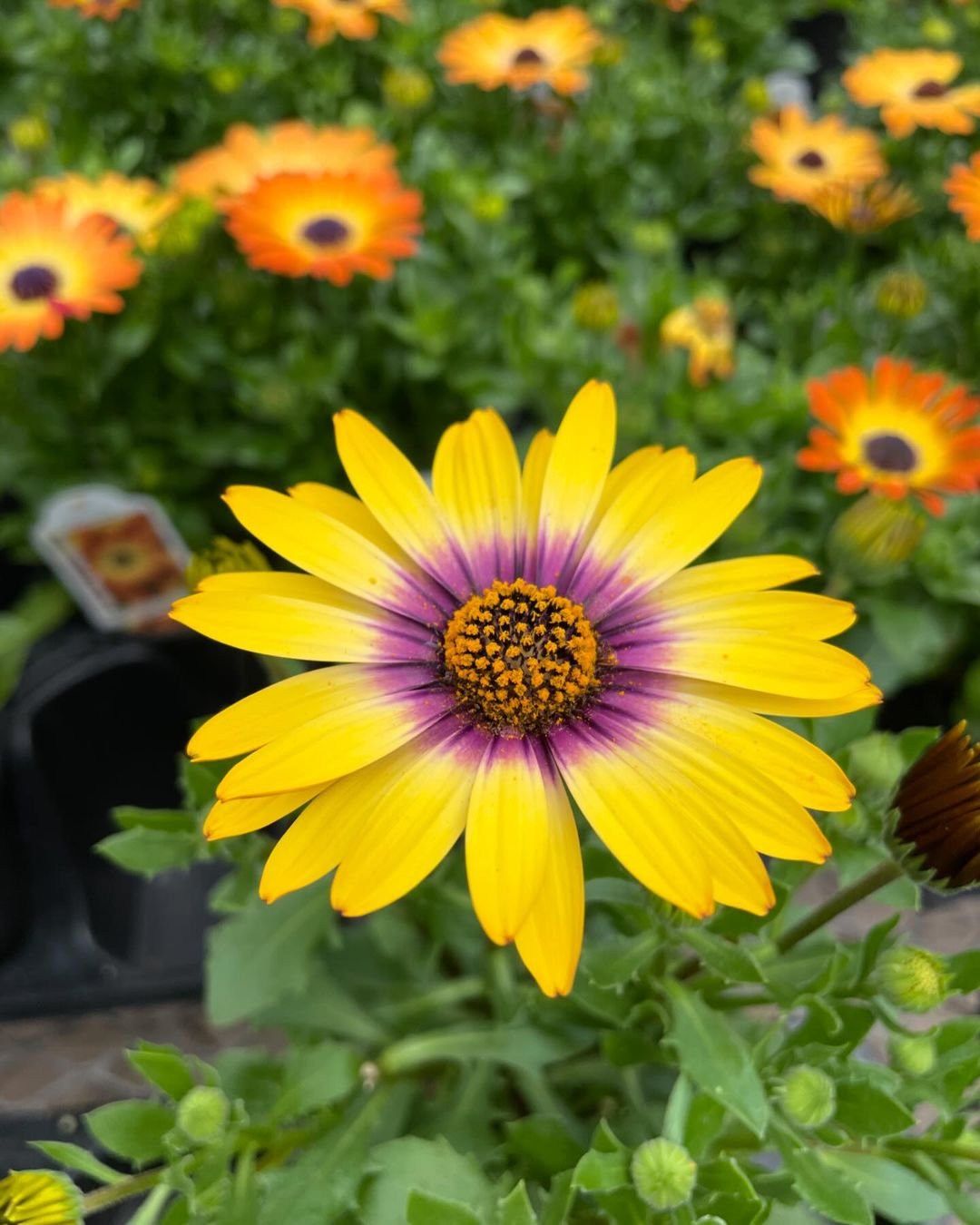
Here’s a short information chart for Osteospermum (Osteospermum spp.):
| Aspect | Details |
|---|---|
| Botanical Name | Osteospermum spp. |
| Common Name | Osteospermum |
| Plant Type | Perennial herbaceous plant |
| Zones | USDA zones 9-11 (typically grown as an annual in colder climates) |
| Sun Exposure | Full sun to part shade |
| Soil Type | Well-draining, sandy to loamy soil |
| Watering | Moderate; drought tolerant once established |
| Growth Habit | Low-growing, spreading |
| Height/Spread | Typically grows 6-12 inches tall with a spread of 12-24 inches |
| Special Features | Daisy-like flowers in various shades of purple, pink, blue or white, blooms profusely from spring to fall, attractive to butterflies and bees, excellent for borders, containers or ground cover |
The Osteospermum, also known as the “African Daisy,” is a delightful sunflower lookalike. These daisy-like flowers feature vibrant yellow or orange petals surrounding a prominent dark center, reminiscent of a sunflower’s classic design. Osteospermums are low-maintenance and drought-tolerant, making them an excellent choice for gardeners in warm climates or those seeking a sunflower-inspired bloom that thrives with minimal care.
8. Calendula (Calendula officinalis)

Here’s a short information chart for Calendula (Calendula officinalis):
| Aspect | Details |
|---|---|
| Botanical Name | Calendula officinalis |
| Common Name | Calendula, Pot Marigold |
| Plant Type | Annual herbaceous plant |
| Zones | USDA zones 2-11 (grown as an annual in colder climates) |
| Sun Exposure | Full sun to part shade |
| Soil Type | Well-draining, average soil |
| Watering | Moderate; tolerate drought once established |
| Growth Habit | Upright, bushy |
| Height/Spread | Typically grows 12-24 inches tall with a spread of 12-18 inches |
| Special Features | Bright yellow or orange flowers with medicinal and culinary uses, blooms from spring to fall, attractive to pollinators, edible petals used in salads and teas |
The Calendula, also known as the “Pot Marigold,” is a cheerful sunflower doppelganger that adds a touch of warmth and vibrancy to any garden. These edible flowers feature layers of bright yellow or orange petals surrounding a distinctive center, mimicking the radiant beauty of a sunflower. Calendulas are not only beautiful but also easy to grow, making them a fantastic choice for beginner gardeners or those seeking a low-maintenance sunflower lookalike.
9. Sunburst Sunflower (Helianthus annuus)
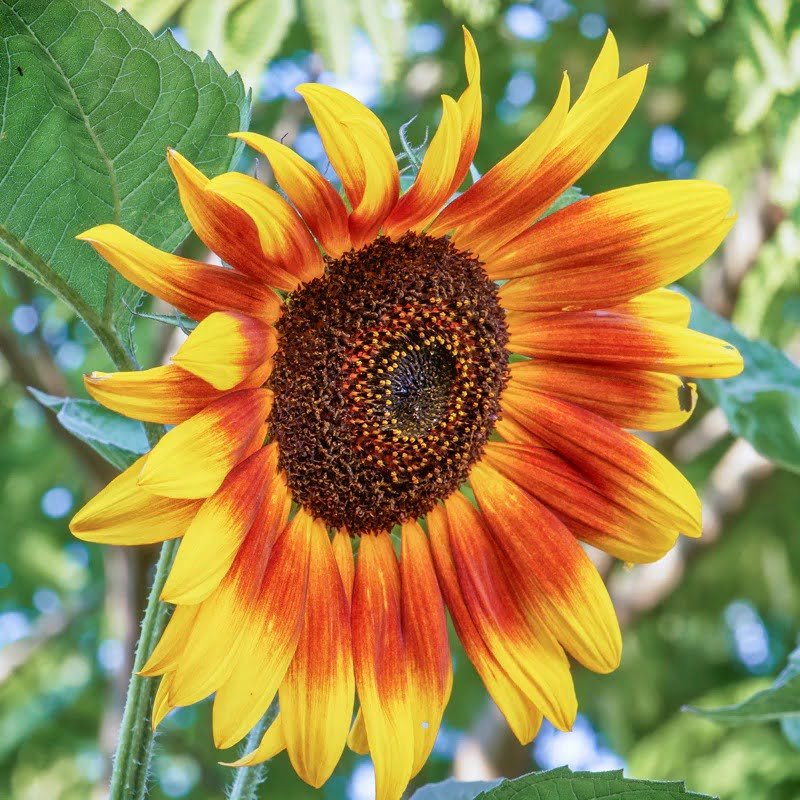
Here’s a short information chart for Sunburst Sunflower (Helianthus annuus):
| Aspect | Details |
|---|---|
| Botanical Name | Helianthus annuus |
| Common Name | Sunburst Sunflower |
| Plant Type | Annual herbaceous plant |
| Zones | USDA zones 4-9 |
| Sun Exposure | Full sun |
| Soil Type | Well-draining, fertile soil |
| Watering | Regular; drought tolerant once established |
| Growth Habit | Upright, tall |
| Height/Spread | Typically grows 3-8 feet tall with a spread of 1-3 feet |
| Special Features | Large, bright yellow flowers with dark centers, blooms from mid-summer to fall, attracts pollinators, edible seeds |
While not a separate species, the Sunburst Sunflower deserves a spot on this list for its unique and mesmerizing appearance. These sunflowers feature a stunning display of elongated, twisted petals that radiate outward from a central dark disc, creating a captivating sunburst effect. With their vibrant yellow hues and dramatic form, Sunburst Sunflowers are a true showstopper in any garden or floral arrangement.
10. Sunflower Daisy (Heliopsis helianthoides)

Here’s a short information chart for Sunflower Daisy (Heliopsis helianthoides):
| Aspect | Details |
|---|---|
| Botanical Name | Heliopsis helianthoides |
| Common Name | Sunflower Daisy |
| Plant Type | Herbaceous perennial |
| Zones | USDA zones 3-9 |
| Sun Exposure | Full sun to part shade |
| Soil Type | Well-draining, fertile soil |
| Watering | Moderate; drought tolerant once established |
| Growth Habit | Upright, clumping |
| Height/Spread | Typically grows 2-5 feet tall with a spread of 1-3 feet |
| Special Features | Daisy-like flowers in shades of yellow or orange with a dark center, blooms from mid-summer to fall, attracts butterflies and bees, deer resistant |
Last but not least, the Sunflower Daisy is a true sunflower doppelganger that lives up to its name. These perennial flowers feature golden-yellow petals surrounding a prominent brown or dark center, creating a striking resemblance to a classic sunflower. Sunflower Daisies are not only beautiful but also drought-tolerant and low-maintenance, making them a fantastic choice for gardeners seeking a sunflower-inspired bloom that thrives with minimal effort.
Exploring these sunflower doppelgangers is a delightful journey into the vibrant and diverse world of nature’s artistry. Whether you’re a seasoned gardener or simply someone who appreciates the beauty of sunflowers, these stunning blooms offer a unique and captivating twist on the classic sunflower aesthetic. From the bold and fiery Mexican Sunflower to the cheerful and low-maintenance Calendula, there’s a sunflower doppelganger to suit every garden and preference.
So, why settle for ordinary when you can add a touch of sunflower charm to your outdoor spaces with these radiant beauties? Embrace the warmth and vibrancy of these sunflower doppelgangers and let them brighten up your garden with their radiant blooms and sunflower-inspired splendor.
Pingback: Sunflowers: Varieties, Planting Tips and Care Techniques
Pingback: Finches of Michigan: Exploring the Diverse Species